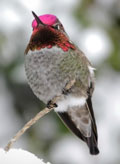A major challenge
 Chestnut-breasted Coronet, near the Machu Picchu in Peru Boissonneaua matthewsiiCredit: Mike LaBarbera(Size: 105.31 kb) |
Conserving energy is a significant physiological challenge for hummingbirds. The smaller an animal is, the more quickly it loses heat. However, the smaller the body, the easier it is to reach all parts and regulate temperature. The challenge to maintain acceptable body temperatures is particularly high for hummingbirds that live in the mountains, nearly 50% of the species. Daily temperature variations can be more than 15ºC. Certain species, like the Bearded Helmetcrest (Oxypogon guerinii) and the White-tailed Hillstar (Urochroa bougueri) rarely leave the snow-covered slopes of the Andes at an altitude of 4000 m. On very cold nights, they take refuge in caves or under a thick cover of vegetation. Despite the rigours of the climate, they are well adapted to these regions and reproduce successfully without much competition. The body temperature of hummingbirds usually stays between 40 and 42°C.
Wingbeats
 Anna's Hummingbird Calypte annaCredit: Louis Carlos(Size: 22.36 kb) |
When the outside temperature is low, hummingbirds have recourse to simple methods, such as muscle contraction, to produce more heat. By increasing the frequency of wingbeats, but reducing the range, they succeed in producing more heat while controlling their flight. However, this mechanism demands high energy use that must be compensated for with a continual supply of food.
The right mix
 Unidentified species Credit: Christomopher(Size: 59.27 kb) |
The hummingbird's main challenge is to accumulate enough energy to compensate for the loss experienced when maintaining its temperature. Hummingbirds are exposed to significant time pressures. They must see to their daily food requirements and accumulate sufficient reserves to survive their night-time fasting. The quality and accessibility of food are essential. These are the first birds to head out at dawn and the last to stop at dusk. Long periods of inactivity between daily meals are vital to keep energy consumption at a minimum.
 Anna's Hummingbird Calypte annaCredit: Frank Leung(Size: 49.11 kb) |
Torpor
To survive cold nights, hummingbirds may enter a temporary dormant state known as torpor. During these periods, their heart rate goes down to 50 beats per minute, and their respiration is reduced by 50%. In this way, they manage to maintain their body temperature at between 18 and 20ºC. However, they then become lethargic and unable to effectively react to external stimuli. Although they are at the mercy of predators, the energy savings during this period of immobility is considerable, almost 60% of the total energy accumulated during the day. |

